
Overproofed!

Over-proofing is often blamed for collapse in the oven. This is not always the case, as will be illustrated in this posting. A fully developed dough with good gas retention properties will not collapse in the oven, but will instead grow enormous in size. Baking this loaf was an experiment in extreme over-proofing, and an investigation into the causes of collapse in the oven.
The experimental loaf was formulated and baked the same way as Buttermilk Twist White Bread (Re-mix Method), only the loaf was not twisted. Optimum proof height was reached in about 70 minutes, but proofing was allowed to continue for an additional 50 minutes, giving a total proof time of 120 minutes. The maximum dough height reached 5” (127mm), which is about an inch higher than normal. Oven spring was tremendous, and the final baked loaf was well over 6” high.
So, it is established that over-proofing causes excessive loaf volume. But what about collapse? Offered below are two quotes from Baking Science and Technology by E. J. Pyler:
“Overproofing is recognized by loaves possessing pale crust color, coarse grain, poor texture, unsatisfactory keeping quality and undesirable flavor caused by excessive acid development. In the case of green or weak flours, it also results in poor loaf volume brought about by a collapse in the oven.” (Second edition, p 676)
Green flour is flour that has been freshly milled.
“Freshly milled flour that has not received artificial maturing treatment will generally give variable baking results and produce bread that is inferior in volume, texture, and grain to bread made from the same flour after a period of storage.” (Second edition p 352)
Conclusions:
1) Fully developed dough made with strong flour will cause excessive volume if over-proofed.
2) Using weak flour (such as all-purpose) when strong flour is called for may cause collapse if a loaf is over-proofed.
3) Freshly milled (or “green”) flour may give inconsistent results. Over-proofing is likely to cause collapse in the oven.
4) Storage (under the proper conditions) improves the baking quality of flour.
5) When using freshly milled flour, due care should be exercised to avoid over-proofing.
The next two photographs show the dough immediately after being panned:

After 70 minutes, the dough is ready for the oven: 
After 120 minutes, the dough is overproofed, and goes into the oven:
Immediately after baking: 
And after cooling:



I've overproofed my bread before, and the results I got were similar to yours. In addition to being very high and lofty, it was also very soft and pillowy. It was so soft my sharpest knife couldn't cut it without either compressing the loaf and cutting crooked, or tearing the loaf as it went. I was using KA Bread flour, at a 70% hydration level, with somewhere around 35% total dough weight of sourdough starter, 2% salt, and no other ingredients. the reason mine was overproofed is because I had to leave the house while it was proofing, and stayed away longer than intended. By the time I got back home and preheated my oven, it was even higher than yours was in the picture above (before baking) and didn't get much, if any, oven spring.
Did you eat that bread? How does it taste?
I ate one slice, although the ears had to be trimmed to get the slice into the toaster. The texture was quite soft, and flavor seemed to be lacking. Some of the jam fell through a hole, too.
Yes, I agree with "conclusion #1"...... I used a good high-gluten bread flour and my sourdough starter. Wanted just a small puffy type "bun" for appetizers and cocktails.
Placed the dough in one of my wife's small spring pans, got busy and forgot about it for over two hours. By that time the only thing I could do is bake it! Company was coming........
Well,,,, it really did a number in the oven.... talk about "oven-spring".... everybody loved it and every last bit was eaten....... we called it "Mary Puff'ns Toad Stool".
Nice work Bob S. You had fun, huh?
Your novelty bread certainly has an interesting appearance. Do you still make it for your guests? There are many instances of mistakes in the kitchen leading to a new creation, like gooey butter cake (a mis-formulated deep butter cake). If Martha Stewart ever shows up for dinner, you can always impress her with Mary Puff'ns Toad Stool.
Bob
to what i wopuld call a pale bake. There were plenty of residual sugars left that browned up well enough. With SD I've never had a situation where if over proofed that the dough continued to rise or spring well in the oven. It just sits there with no spring or collapses a little.
I'm surprised it didn't taste at least as good as the normal loaf since they say a longer time in ferment and proof can translate into better flavor in yeast breads and the reason to use poolish. I don't bake with commercial yeast much to know about it personally. This is a very interesting post Bob. Seems like I learn something new every day on this site!
Happy Baking.